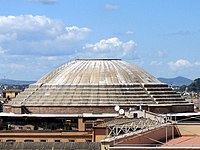
Photo from wikipedia
Development and proposition of a numerical model to capture the shrinkage induced flow during directional solidification of a pure substance in a bottom cooled cavity are carried out. A novel… Click to show full abstract
Development and proposition of a numerical model to capture the shrinkage induced flow during directional solidification of a pure substance in a bottom cooled cavity are carried out. A novel numerical scheme involving fixed grid-based volume fraction updating is proposed to track the solid–liquid interface, considering the inclusion of the shrinkage effect. Directional solidification in bottom cooled orientation is of particular interest since shrinkage and buoyancy effects oppose each other. The results from the proposed numerical model indicated the existence of an unprecedented flow reversal phenomenon during the progression of the solidification process, caused by the opposing nature of shrinkage and buoyancy effects. The flow reversal phenomena predicted by the numerical model are validated by conducting experiments involving directional solidification of coconut oil in a bottom cooled cavity. Qualitative and quantitative measurements of the velocity field and interface growth are obtained using the particle image velocimetry technique and compared with three dimensional numerical results. Once the flow reversal phenomena are established through numerical and experimental evidences, case studies are performed, considering varying material properties, cold boundary temperatures, initial temperatures of the melt, and cavity heights to find the effect of each of these parameters on flow reversal phenomena. The parametric study also allowed us to check the robustness and consistency of the proposed model. The proposed model will serve as an important milestone toward the development of numerical models for capturing macro-scale shrinkage defects and prediction of composition heterogeneity during directional alloy solidification.
Journal Title: Physics of Fluids
Year Published: 2020
Link to full text (if available)
Share on Social Media: Sign Up to like & get
recommendations!